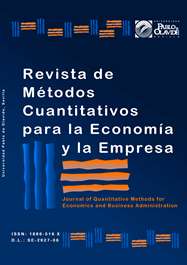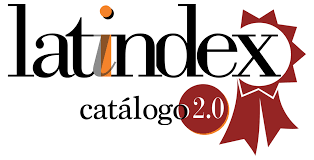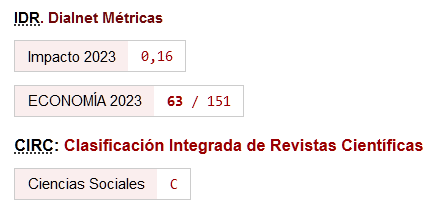Influencia de la Innovación abierta, la Flexibilidad Estratégica y la Gestión de riesgos Corporativos en la Ventaja Competitiva.
Análisis en el Sector Hotelero Portugués.
DOI:
https://doi.org/10.46661/rev.metodoscuant.econ.empresa.7340Palabras clave:
innovación abierta entrante, innovación abierta saliente, ventaja competitiva, industria hotelera, regresión cuantílica., mínimos cuadrados parcialesResumen
Este trabajo analiza los efectos de la innovación abierta (IA), la estrategia organizacional y la existencia de una estrategia de gestión de riesgos corporativos (GRC) sobre la ventaja competitiva (VC) en coste, servicio y producto en el sector hotelero portugués. Se utiliza una encuesta a 251 directores ejecutivos de hoteles de pequeñas y medianas empresas (PYME) portuguesas sobre la que se aplica dos métodos estadísticos complementarios: regresión con mínimos cuadrados parciales y regresión cuantílica. Puede afirmarse que tanto la IA como el grado de dinamismo y flexibilidad de la estructura organizativa y la GRC son relevantes para explicar los diferentes tipos de ventaja competitiva. No obstante, los resultados muestran que la importancia de la incidencia de los diferentes factores explicativos considerados es diferente en función del tipo de ventaja competitiva que estemos analizando y, asimismo, la relevancia de desagregar los asociados a la IA (entrante y saliente) y a estrategia organizacional (dinamismo del ambiente, flexibilidad organizativa interna y posición estratégica innovadora). Así, la variable GRC es la variable fundamental en la explicación de la ventaja competitiva en coste, mientras que la incidencia de la IA entrante es especialmente relevante en las VCs en servicio y producto. Dentro de la estrategia organizacional, el factor que incide más claramente en la ventaja competitiva es la posición estratégica respecto a la innovación.
Descargas
Citas
Abhari, K. & McGuckin, K. (2022). Limiting factors of open innovation organizations: A case of social product development and research agenda. Technovation, 102526, https://doi.org/10.1016/j.technovation.2022.102526.
Barmuta, K. A., Akhmetshin, E. M., Andryushchenko, I. Y., Tagibova, A. A., Meshkova, G. V. & Zekiy, A. O. (2020). Problems of business processes transformation in the context of building digital economy. Entrepreneurship and Sustainability Issues, 8(1), 945 http://doi.org/10.9770/jesi.2020.8.1(63)
Bril, A., Kalinina, O., Valebnikova, O., Valebnikova, N., Camastral, M., Shustov, D. O. & Trovskaya, N. (2021). Improving Personnel Management by Organizational Projects: Implications for Open Innovation. Journal Open Innovation Technology, 7(105), 1-16. https://doi.org/10.3390/joitmc7020105.
Brozovic, D. (2018). Strategic flexibility: A review of the literature. International Journal of Management Reviews, 20(1), 3-31. https://doi.org/10.1111/ijmr.12111.
Chaudhary, S., Kaur, P., Talwar, S., Islam, N. & Dhir, A. (2022). Way off the mark? Open innovation failures: Decoding what really matters to chart the future course of action. Journal of Business Research, 142, 1010-1025. https://doi.org/10.1016/j.jbusres.2021.12.062.
Cheng, C.C.J. & Huizingh, E.K.R.E. (2014). When Is Open Innovation Beneficial? The Role of Strategic Orientation. Journal of Product Innovation Management, 31(6), 1235–1253. https://doi.org/10.1111/jpim.12148.
Chesbrough, H. & Bogers, M. (2014). Clarifying an emerging paradigm for understanding innovation. En H. Chesbrough, W. Vanhaverbeke & J. West (Eds.), New Frontiers in Open Innovation (pp. 3-28). Oxford University Press.
https://doi.org/10.1093/acprof:oso/9780199682461.001.0001
Chiaroni. D., Chiesa. V. & Frattini F. (2011). The Open Innovation Journey: How Firms Dynamically Implement the Emerging Innovation Management Paradigm. Technovation, 31(1), 34-43. https://doi.org/10.1016/j.technovation.2009.08.007.
Covin, J.G. & Slevin, D.P. (1989). Strategic Management of Small Firms is Hostile and Benign Environments. Journal Strategic of Management, 10(1), 75-87. https://doi.org/10.1108/MBE-07-2013-0042.
Crema, M., Verbano. C. & Venturini, K. (2014). Linking strategy with open innovation and performance in SMEs. Measuring Business Excellence, 18(2), 14-27. https://doi.org/10.1108/MBE-07-2013-0042.
Dahlander, L., Gann, D. M. & Wallin, M. W. (2021). How open is innovation? A retrospective and ideas forward. Research Policy, 50(4), 104218. https://doi.org/10.1016/j.respol.2021.104218
Elahi, E. (2013). Risk management: the next source of competitive advantage. Foresight, 15 (2), 117-131. https://doi.org/10.1108/14636681311321121.
Fedriani Martel, E. M. & Romano Paguillo, I. (2017). Análisis cualitativo comparativo difuso para determinar influencias entre variables socio-económicas y el rendimiento académico de los universitarios. Revista de Métodos Cuantitativos para la Economía y la Empresa, 24, 250-269. https://www.upo.es/revistas/index.php/RevMetCuant/article/view/2889
Fornell, C. & Larcker, D. (1981). Evaluating structural equation models with unobserved variables and measurement error. Journal of Marketing Research, 18(1), 39-50. https://doi.org/10.1177/002224378101800104.
Giannoccaro, I. (2018). Centralized vs. decentralized supply chains: The importance of decision maker’s cognitive ability and resistance to change. Industrial Marketing Management, 73, 59-69. https://doi.org/10.1016/j.indmarman.2018.01.034.
Greco, M., Grimaldi, M. & Cricelli, L. (2015). Open innovation actions and innovation performance: A literature review of European empirical evidence. European Journal of Innovation Management, 18(2), 150–171. https://doi.org/10.1108/EJIM-07-2013- 0074
Hair, J.F., Risher, J.J., Sarstedt, M. & Ringle, C.M. (2019). When to use and how to report the results of PLS-SEM. European Business Review, 31(1), 2-24. https://doi.org/10.1108/EBR-11-2018-0203
Hamelink, M. & Opdenakker, R. (2019). How business model innovation affects firm performance in the energy storage market. Renewable Energy, 131, 120-127. https://doi.org/10.1016/j.renene.2018.07.051.
Hansen, M. T. & Nohria, N. (2004). How to build collaborative advantage. MIT Sloan Management Review, 46(1), 22-30.
Kaleka, A. (2002). Resources and capabilities driving competitive advantage in export markets: guidelines for industrial exporters. Industrial Marketing Management, 31(3), 273-283. https://doi.org/10.1016/S0019-8501(00)00148-6.
Koenker R. & Bassett Jr G. (1978). Regression quantiles. Econometrica, 46(1), 33-50. https://doi.org/10.2307/1913643.
Koenker, R. & Hallock, K. F. (2001). Quantile regression. Journal of Economic Perspectives, 15(4), 143-156. https://doi.org/10.1257/jep.15.4.143.
Lee, J., Minb, J. & Lee, H. (2016). The Effect of Organizational Structure on Open Innovation: A Quadratic Equation. Procedia Computer Science, 91, 492-501. https://doi.org/10.1016/j.procs.2016.07.128.
Lee, S., Park, G. Yoon, J., & Park, J. (2010). Open innovation in SMEs: An intermediated network model. Research Policy, 39, 290–300. https://doi.org/10.1016/j.respol.2009.12.009.
Lichtenthaler, U. (2009). Outbound open innovation and its effect on firm performance: examining environmental influences. R&D Management, 39(4), 317-330. https://doi.org/10.1111/j.1467-9310.2009.00561.x.
Lichtenthaler, U. (2011). Open innovation: Past research, current debates, and future directions. Academy of Management Perspectives, 25(1), 75-93. https://doi.org/10.5465/amp.25.1.75.
Lu, Q. & Chesbrough, H. (2021). Measuring open innovation practices through topic modelling: Revisiting their impact on firm financial performance, Technovation, 114, 102434, https://doi.org/10.1016/j.technovation.2021.102434.
Michelino, F., Caputo, M., Cammarano, A. & Lamberti, E. (2014). Inbound and outbound open innovation: organization and performances. Journal of Technology Management & Innovation, 9(3), 65-82. http://dx.doi.org/10.4067/S0718-27242014000300005.
Moradi, E., Mohammadbagher, S.J., Mohammadi, Z.D. & Mirzaei, A. (2021), Impact of organizational inertia on business model innovation, open innovation and corporate performance. Asia Pacific Management Review, 26(4), 171-179. https://doi.org/10.1016/j.apmrv.2021.01.003.
Morgan, P,M., Jeffrey, G.C. & Michael, B.H. (2000), The Relationship between Environmental Dynamism and Small Firm Structure, Strategy, and Performance. Journal of Marketing Theory and Practice. The Marketing and Entrepreneurship Interface, 8(2), 63-78. https://doi.org/10.1080/10696679.2000.11501869.
Musiello-Neto, F., Rua, O.L., Arias-Oliva, M. & Silva, A.F. (2021). Open Innovation and Competitive Advantage on the Hospitality Sector: The Role of Organizational Strategy. Sustainability, 13(24), 13650. https://doi.org/10.3390/su132413650.
Nayak, B., Bhattacharyya, S. S. & Krishnamoorthy, B. (2022). Exploring the black box of competitive advantage–An integrated bibliometric and chronological literature review approach. Journal of Business Research, 139, 964-982. https://doi.org/10.1016/j.jbusres.2021.10.047.
Nocco, B.W. & Stulz, R.M. (2006). Enterprise risk management: theory and practice. Journal of Applied Corporate Finance, 18(4), 8-20. https://doi.org/10.1111/j.1745-6622.2006.00106.x.
Rua, O.L. França, A., & Fernández, R.O. (2018). Key drivers of SMEs export performance: the mediating effect of competitive advantage. Journal of Knowledge Management, 22(2), 257–270. https://doi.org/10.1108/JKM-07-2017-0267.
Siggelkow, N. & Levinthal, D., A. (2003), Temporarily Divide to Conquer: Centralized, Decentralized, and Reintegrated Organizational Approaches to Exploration and Adaptation. Organization Science, 14(6), 650-669. https://doi.org/10.1287/orsc.14.6.650.24840.
Sisodiya, S.R., Johnson, J.L. & Grégoire, Y. (2013) Inbound open innovation for enhanced performance: Enablers and opportunities. Industrial Marketing Management, 42(5), 836-849. https://doi.org/10.1016/j.indmarman.2013.02.018.
Skordoulis, M., Ntanos., S., Kyriakopoulos, G.L., Arabatzis., G., Galatsidas., S. & Chalikia., M. (2020). Environmental Innovation, Open Innovation Dynamics and Competitive Advantage of Medium and Large-Sized Firms. Journal of Open Innovation: Technology, Market, and Complexity, 6(4), 1-30. https://doi.org/10.3390/joitmc6040195.
Skourtis, G., D´Ecaudin, J. M., Assiouras, I. & Karaosmanoglu, E. (2019). Does the cocreation of service recovery create value for customers? The underlying mechanism of motivation and the role of operant resources. European Management Review, 16(4), 997–1013. https://doi.org/10.1111/emre.12301.
Soriano, J. L. & Mejía-Trejo, J. (2022). Modelado de Ecuaciones Estructurales en el campo de las Ciencias de la Administración. Revista de Métodos Cuantitativos para la Economía y la Empresa, 33, 242-263.
https://doi.org/10.46661/revmetodoscuanteconempresa.5414
Sutanto, E. M. (2017). The influence of organizational learning capability and organizational creativity on organizational innovation of Universities in East Java, Indonesia. Asia Pacific Management Review, 22(3), 128-135. https://doi.org/10.1016/j.apmrv.2016.11.002.
Terán-Bustamante, A., Martínez-Velasco, A. & Dávila-Aragón, G. (2021) Knowledge Management for Open Innovation: Bayesian Networks through Machine Learning. Journal Open Innovation Technology. Market and Complexity, 7(1), 40. https://doi.org/10.3390/joitmc7010040.
Parodi, C. (2018). La gran desaceleración económica mundial 2011-2015 (Documento de discusión No. 1804). Universidad del Pacífico. http://repositorio.up.edu.pe/handle/11354/2060
Vicéns-Otero, J.V. & Sánchez-Reyes, B. (2012). Regresión Cuantílica: estimación y contrastes (Documento de Trabajo No. 21). Instituto LR Klein-Centro Gauss. https://www.uam.es/uam/media/doc/1606862082401/regresion-cuantilica-estimacion-y-contrastes.pdf.
Wong, E.M., Ormiston, M.E. & Tetlock, P.E. (2011). The effects of top management team integrative complexity and decentralized decision making on corporate social performance. Academy of Management Journal, 54(6), 1207-1228. https://doi.org/10.5465/amj.2008.0762
Yang, Z.J., Lin, J. & Yang, Y., S. (2021), Identification of network behavioral characteristics of high-expertise users in interactive innovation: The case of forum autohome. Asia Pacific Management Review, 26(1), 11-22. https://doi.org/10.1016/j.apmrv.2020.06.002.
Publicado
Cómo citar
Número
Sección
Licencia
Derechos de autor 2023 Jorge de Andres-Sanchez, Eugenio Musiello-Neto, Orlando Lima-Rúa, Mario Arias-Oliva

Esta obra está bajo una licencia internacional Creative Commons Atribución-CompartirIgual 4.0.
El envío de un manuscrito a la Revista supone que el trabajo no ha sido publicado anteriormente (excepto en la forma de un abstract o como parte de una tesis), que no está bajo consideración para su publicación en ninguna otra revista o editorial y que, en caso de aceptación, los autores están conforme con la transferencia automática del copyright a la Revista para su publicación y difusión. Los autores retendrán los derechos de autor para usar y compartir su artículo con un uso personal, institucional o con fines docentes; igualmente retiene los derechos de patente, de marca registrada (en caso de que sean aplicables) o derechos morales de autor (incluyendo los datos de investigación).
Los artículos publicados en la Revista están sujetos a la licencia Creative Commons CC-BY-SA de tipo Reconocimiento-CompartirIgual. Se permite el uso comercial de la obra, reconociendo su autoría, y de las posibles obras derivadas, la distribución de las cuales se debe hacer con una licencia igual a la que regula la obra original.
Hasta el volumen 21 se ha estado empleando la versión de licencia CC-BY-SA 3.0 ES y se ha comenzado a usar la versión CC-BY-SA 4.0 desde el volumen 22.










